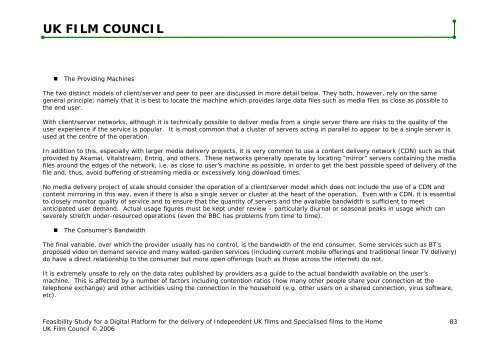Feasibility Study of a Digital Platform for the delivery of UK ... - BFI
Feasibility Study of a Digital Platform for the delivery of UK ... - BFI
Feasibility Study of a Digital Platform for the delivery of UK ... - BFI
Create successful ePaper yourself
Turn your PDF publications into a flip-book with our unique Google optimized e-Paper software.
<strong>UK</strong> FILM COUNCIL<br />
The Providing Machines<br />
The two distinct models <strong>of</strong> client/server and peer to peer are discussed in more detail below. They both, however, rely on <strong>the</strong> same<br />
general principle; namely that it is best to locate <strong>the</strong> machine which provides large data files such as media files as close as possible to<br />
<strong>the</strong> end user.<br />
With client/server networks, although it is technically possible to deliver media from a single server <strong>the</strong>re are risks to <strong>the</strong> quality <strong>of</strong> <strong>the</strong><br />
user experience if <strong>the</strong> service is popular. It is most common that a cluster <strong>of</strong> servers acting in parallel to appear to be a single server is<br />
used at <strong>the</strong> centre <strong>of</strong> <strong>the</strong> operation.<br />
In addition to this, especially with larger media <strong>delivery</strong> projects, it is very common to use a content <strong>delivery</strong> network (CDN) such as that<br />
provided by Akamai, Vitalstream, Entriq, and o<strong>the</strong>rs. These networks generally operate by locating “mirror” servers containing <strong>the</strong> media<br />
files around <strong>the</strong> edges <strong>of</strong> <strong>the</strong> network, i.e. as close to user’s machine as possible, in order to get <strong>the</strong> best possible speed <strong>of</strong> <strong>delivery</strong> <strong>of</strong> <strong>the</strong><br />
file and, thus, avoid buffering <strong>of</strong> streaming media or excessively long download times.<br />
No media <strong>delivery</strong> project <strong>of</strong> scale should consider <strong>the</strong> operation <strong>of</strong> a client/server model which does not include <strong>the</strong> use <strong>of</strong> a CDN and<br />
content mirroring in this way, even if <strong>the</strong>re is also a single server or cluster at <strong>the</strong> heart <strong>of</strong> <strong>the</strong> operation. Even with a CDN, it is essential<br />
to closely monitor quality <strong>of</strong> service and to ensure that <strong>the</strong> quantity <strong>of</strong> servers and <strong>the</strong> available bandwidth is sufficient to meet<br />
anticipated user demand. Actual usage figures must be kept under review – particularly diurnal or seasonal peaks in usage which can<br />
severely stretch under-resourced operations (even <strong>the</strong> BBC has problems from time to time).<br />
The Consumer’s Bandwidth<br />
The final variable, over which <strong>the</strong> provider usually has no control, is <strong>the</strong> bandwidth <strong>of</strong> <strong>the</strong> end consumer. Some services such as BT’s<br />
proposed video on demand service and many walled-garden services (including current mobile <strong>of</strong>ferings and traditional linear TV <strong>delivery</strong>)<br />
do have a direct relationship to <strong>the</strong> consumer but more open <strong>of</strong>ferings (such as those across <strong>the</strong> internet) do not.<br />
It is extremely unsafe to rely on <strong>the</strong> data rates published by providers as a guide to <strong>the</strong> actual bandwidth available on <strong>the</strong> user’s<br />
machine. This is affected by a number <strong>of</strong> factors including contention ratios (how many o<strong>the</strong>r people share your connection at <strong>the</strong><br />
telephone exchange) and o<strong>the</strong>r activities using <strong>the</strong> connection in <strong>the</strong> household (e.g. o<strong>the</strong>r users on a shared connection, virus s<strong>of</strong>tware,<br />
etc).<br />
<strong>Feasibility</strong> <strong>Study</strong> <strong>for</strong> a <strong>Digital</strong> <strong>Plat<strong>for</strong>m</strong> <strong>for</strong> <strong>the</strong> <strong>delivery</strong> <strong>of</strong> Independent <strong>UK</strong> films and Specialised films to <strong>the</strong> Home<br />
<strong>UK</strong> Film Council © 2006<br />
83
















